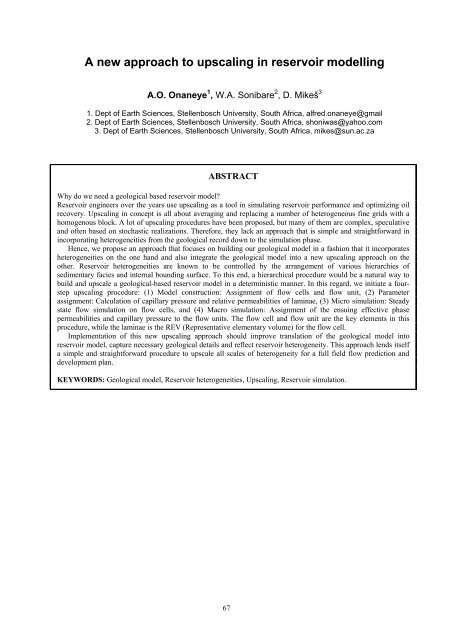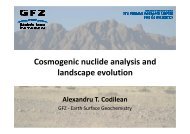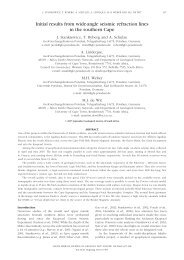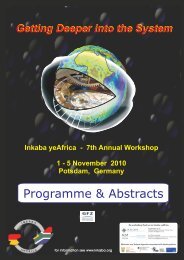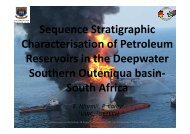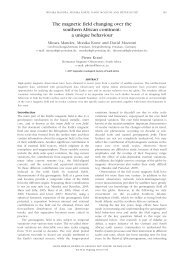South Africa - Inkaba.org
South Africa - Inkaba.org
South Africa - Inkaba.org
Create successful ePaper yourself
Turn your PDF publications into a flip-book with our unique Google optimized e-Paper software.
A new approach to upscaling in reservoir modelling<br />
A.O. Onaneye 1 , W.A. Sonibare 2 , D. Mikeš 3<br />
1. Dept of Earth Sciences, Stellenbosch University, <strong>South</strong> <strong>Africa</strong>, alfred.onaneye@gmail<br />
2. Dept of Earth Sciences, Stellenbosch University, <strong>South</strong> <strong>Africa</strong>, shoniwas@yahoo.com<br />
3. Dept of Earth Sciences, Stellenbosch University, <strong>South</strong> <strong>Africa</strong>, mikes@sun.ac.za<br />
ABSTRACT<br />
Why do we need a geological based reservoir model?<br />
Reservoir engineers over the years use upscaling as a tool in simulating reservoir performance and optimizing oil<br />
recovery. Upscaling in concept is all about averaging and replacing a number of heterogeneous fine grids with a<br />
homogenous block. A lot of upscaling procedures have been proposed, but many of them are complex, speculative<br />
and often based on stochastic realizations. Therefore, they lack an approach that is simple and straightforward in<br />
incorporating heterogeneities from the geological record down to the simulation phase.<br />
Hence, we propose an approach that focuses on building our geological model in a fashion that it incorporates<br />
heterogeneities on the one hand and also integrate the geological model into a new upscaling approach on the<br />
other. Reservoir heterogeneities are known to be controlled by the arrangement of various hierarchies of<br />
sedimentary facies and internal bounding surface. To this end, a hierarchical procedure would be a natural way to<br />
build and upscale a geological-based reservoir model in a deterministic manner. In this regard, we initiate a fourstep<br />
upscaling procedure: (1) Model construction: Assignment of flow cells and flow unit, (2) Parameter<br />
assignment: Calculation of capillary pressure and relative permeabilities of laminae, (3) Micro simulation: Steady<br />
state flow simulation on flow cells, and (4) Macro simulation: Assignment of the ensuing effective phase<br />
permeabilities and capillary pressure to the flow units. The flow cell and flow unit are the key elements in this<br />
procedure, while the laminae is the REV (Representative elementary volume) for the flow cell.<br />
Implementation of this new upscaling approach should improve translation of the geological model into<br />
reservoir model, capture necessary geological details and reflect reservoir heterogeneity. This approach lends itself<br />
a simple and straightforward procedure to upscale all scales of heterogeneity for a full field flow prediction and<br />
development plan.<br />
KEYWORDS: Geological model, Reservoir heterogeneities, Upscaling, Reservoir simulation.<br />
67


